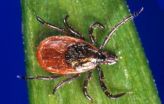(Press-News.org) Thought to dwell mostly near the ocean's surface, Chilean devil rays (Mobula tarapacana) are most often seen gliding through shallow, warm waters. But a new study by scientists at Woods Hole Oceanographic Institution (WHOI) and international colleagues reveals that these large and majestic creatures are actually among the deepest-diving ocean animals.
"So little is known about these rays," said Simon Thorrold, a biologist at WHOI and one of the authors of the paper, published July 1, 2014, in the journal Nature Communications. "We thought they probably travelled long distances horizontally, but we had no idea that they were diving so deep. That was truly a surprise."
Researchers utilized pop-up satellite archival transmitting tags to record the movement patterns of 15 Chilean devil rays in the central North Atlantic Ocean during 2011 and 2012. The tags, which stay on the animals for up to 9 months, also measure water temperature, depth, and light levels of the waters. Once the tags pop off, they float to the surface and beam data via the ARGO satellite system back to computers on shore.
"Data from the tags gives us a three-dimensional view of the movements of these animals, and a window into how they're living in their ocean habitat—where they go, when, and why," Thorrold added.
Devil rays, which can grow as large as four meters (13 feet) across, are ocean nomads travelling large areas of the ocean. Dive data from the tags showed individuals also routinely descended at speeds up to 6 meters per second (13.4 miles per hour) to depths of almost 2,000 meters (1.24 miles) in water temperatures less than 4 degrees Celsius (39.2 degrees Fahrenheit).
The deep dives generally followed two distinct patterns. The most common involved descent to the maximum depth followed by a slower, stepwise return to the surface with a total dive time of 60 to 90 minutes. The tagged rays generally only made one such dive during a 24-hour period. In the second dive pattern, individuals descended and then remained at depths of up to 1,000 meters (3,280 feet) for as long as 11 hours.
During the day, the rays would spend time up at the surface—presumably heating up—immediately before, and then again, after a deep dive. How else might these animals be dealing with the cold temperatures of the deep ocean?
A previous study in the 1970s found that several species of devil rays possess a physiological adaptation —well-developed blood vessels around the cranial cavity that essentially serve as heat exchange systems. At the time, it was hypothesized that the rays must be using this adaptation to cool down rather than warm up.
"Rays were always seen in very warm water up at the surface, so why would they need an adaptation for cold water? Once we looked at the dive data from the tags, of course it made perfect sense that the rays have these systems. Sometimes they're down diving for two or three hours in very cold water — two to three degrees Celsius (35.6 to 37.4 degrees Fahrenheit)," Thorrold said.
While it's not certain what the rays are doing at these depths, the dive profiles suggest that they're foraging on large numbers of fish that live in deeper waters.
"There's an enormous amount of biomass in the deep ocean that we're only starting to understand the significance of," said co-author Camrin Braun, a graduate student in the MIT/WHOI Joint Program in Oceanography. "This paper suggests that devil rays are aware of and regularly exploit this resource, which demonstrates an unexpected new link between the surface and deep ocean."
Devil rays are coming under increasing pressures from fishing, particularly in the Indian and Pacific Oceans. Manta gill rakers are targeted for Chinese medicine, and their cartilage is used as filler in shark fin soup.
"Ultimately, answering whether these animals depend on the deep layers of the ocean for their feeding and survival could have major implications for their management and that of oceanic habitats," added co-author Pedro Afonso, a researcher at the Institute of Marine Research (IMAR) at the University of the Azores and the Laboratory of Robotics and Systems in Engineering and Science (LARSyS).
Little is known about the life span of devil rays or at what age they reproduce. Like other large rays, devil rays are thought to have just one pup born per litter about every two years.
"With those kinds of low reproductive rates, any type of mortality is going to have a big impact on the species," Thorrold said. "We don't know enough about devil rays to even know if we should be worried about their status. There are lines of evidence to suggest we ought to be worried, or at least that we should be trying to learn more about the biology and ecology of these rays."
INFORMATION:
Researchers from the King Abdullah University of Science and Technology (KAUST) and Massachusetts Marine Fisheries also contributed to the study. Funding for this research came from the National Science Foundation, The Harrison Foundation, Rodney and Elizabeth Berens, the King Abdullah University of Science and Technology, Portuguese Foundation for Science and Technology/ Ministry of Education and Science, the LARSyS Strategic Project, and WHOI.
The Woods Hole Oceanographic Institution is a private, non-profit organization on Cape Cod, Mass., dedicated to marine research, engineering, and higher education. Established in 1930 on a recommendation from the National Academy of Sciences, its primary mission is to understand the ocean and its interaction with the Earth as a whole, and to communicate a basic understanding of the ocean's role in the changing global environment. For more information, please visit http://www.whoi.edu.
Tags reveal Chilean devil rays are among ocean's deepest divers
2014-07-01
ELSE PRESS RELEASES FROM THIS DATE:
Bringing the bling to antibacterials
2014-07-01
WASHINGTON D.C., July 1, 2014 – Bacteria love to colonize surfaces inside your body, but they have a hard time getting past your rugged, salty skin. Surgeries to implant medical devices often give such bacteria the opportunity needed to gain entry into the body cavity, allowing the implants themselves to act then as an ideal growing surface for biofilms.
A group of researchers at the Shanghai Institute of Ceramics in the Chinese Academy of Sciences are looking to combat these dangerous sub-dermal infections by upgrading your new hip or kneecap in a fashion appreciated ...
Efforts to cut unnecessary blood testing bring major decreases in health care spending
2014-07-01
Researchers at Johns Hopkins Bayview Medical Center used two relatively simple tactics to significantly reduce the number of unnecessary blood tests to assess symptoms of heart attack and chest pain and to achieve a large decrease in patient charges.
The team provided information and education to physicians about proven testing guidelines and made changes to the computerized provider order entry system at the medical center, part of the Johns Hopkins Health System. The guidelines call for more limited use of blood tests for so-called cardiac biomarkers. A year after implementation, ...
Separating finely mixed oil and water
2014-07-01
CAMBRIDGE, Mass-- Whenever there is a major spill of oil into water, the two tend to mix into a suspension of tiny droplets, called an emulsion, that is extremely hard to separate — and that can cause severe damage to ecosystems. But MIT researchers have discovered a new, inexpensive way of getting the two fluids apart again.
Their newly developed membrane could be manufactured at industrial scale, and could process large quantities of the finely mixed materials back into pure oil and water. The process is described in the journal Scientific Reports by MIT professor Kripa ...
Mayo Clinic researchers reveal treasure trove of genes key to kidney cancer
2014-07-01
JACKSONVILLE, Fla. — A genomic analysis of clear cell renal cell carcinoma (ccRCC), the most common form of kidney cancer, from 72 patients has uncovered 31 genes that are key to development, growth and spread of the cancer, say researchers from Mayo Clinic in Florida. Eight of these genes had not been previously linked to kidney cancer, and six other genes were never known to be involved in any form of cancer.
MULTIMEDIA ALERT: Video and audio are available for download on the Mayo Clinic News Network.
Their study, in the journal Oncotarget, is the most extensive analysis ...
Alcohol use disorders linked to decreased 'work trajectory'
2014-07-01
July 1, 2014 - John D. Meyer, MD, MPH, of Icahn-Mount Sinai School of Medicine, New York, and Miriam Mutambudzi, PhD, MPH, of Johns Hopkins School of Medicine, Baltimore, studied the relationship between occupation and AUDs in workers followed up from early adulthood to middle age. The study focused on the "substantive complexity" of work as an indicator of work trajectory—whether individuals were progressing in their careers in terms of factors such as decision latitude and expanded work abilities.
Based on factors such as drinking more than intended or unsuccessful ...
NIH study reveals gene critical to the early development of cilia
2014-07-01
Researchers at the National Eye Institute (NEI) have described the functions of a gene responsible for anchoring cilia – sensory hair-like extensions present on almost every cell of the body. They show in a mouse model that without the gene Cc2d2a, cilia throughout the body failed to grow, and the mice died during the embryonic stage. The finding adds to an expanding body of knowledge about ciliopathies, a class of genetic disorders that result from defects in the structure or function of cilia. NEI is part of the National Institutes of Health.
The findings are published ...
Smartphone app may revolutionize mental health treatment
2014-07-01
Mental illness accounts for 90 percent of all reported suicides and places the largest burden of any disease on social and economic infrastructures worldwide, according to the World Health Organization. There is a dire need for support services to assist clinicians in the evaluation and treatment of those suffering from mental illness.
New technology developed by researchers at Tel Aviv University is poised to transform the way in which patients with mental illnesses are monitored and treated by clinicians. Dr. Uri Nevo, research team engineer Keren Sela, and scientists ...
Muscle-powered bio-bots walk on command
2014-07-01
Engineers at the University of Illinois at Urbana-Champaign demonstrated a class of walking "bio-bots" powered by muscle cells and controlled with electrical pulses, giving researchers unprecedented command over their function. The group published its work in the online early edition of Proceedings of the National Academy of Science.
"Biological actuation driven by cells is a fundamental need for any kind of biological machine you want to build," said study leader Rashid Bashir, Abel Bliss Professor and head of bioengineering at the U. of I. "We're trying to integrate ...
Reducing deer populations may reduce risk of Lyme disease
2014-07-01
Since white-tailed deer serve as the primary host for the adult blacklegged tick (Ixodes scapularis) — the vector for Lyme disease — scientists have wondered whether reducing the number of deer in a given area would also mean fewer cases of Lyme disease. Now, after a 13-year study was conducted, researchers in Connecticut have found that reduced deer populations can indeed lead to a reduction in Lyme disease cases. The results of their study are published in the Journal of Medical Entomology .
The researchers surveyed 90% of all permanent residents in a Connecticut ...
Enlightening cancer cells
2014-07-01
This news release is available in German.
Harald Janovjak, Assistant Professor at IST Austria, together with Michael Grusch, Associate Professor at the Institute of Cancer Research of the Medical University of Vienna, "remote-controlled" the behaviour of cancer cells with light, as reported this week in EMBO Journal (DOI: 10.15252/embj.201387695). This work is the first application of the new field of optogenetics to cancer research.
To understand the dynamics of cellular signaling, researchers need to activate and inactivate membrane receptor proteins, which ...



